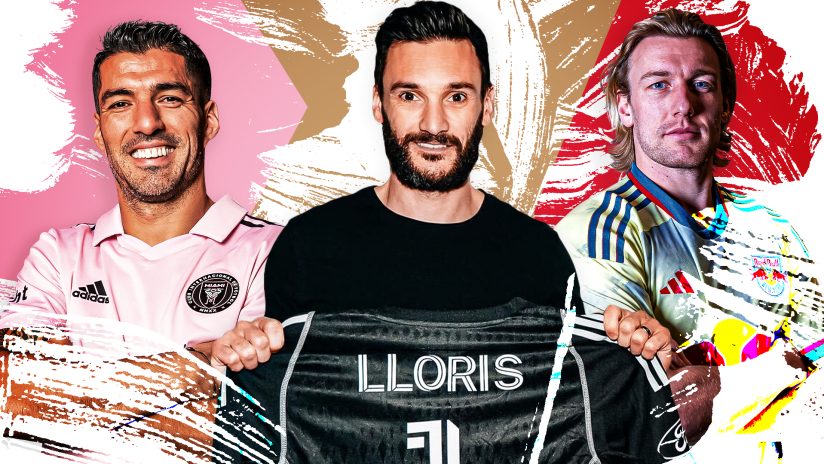Do you know how a cell phone has 'silent mode,' helping limit texts and any other notifications? This year’s MLS offseason is the opposite of that.
Down in Florida, Luis Suárez became the latest addition to Inter Miami CF’s stacked squad. LAFC added another Tottenham legend in goalkeeper Hugo Lloris. And before either of those high-profile moves crossed the finish line, the New York Red Bulls landed Emil Forsberg from sister club RB Leipzig.
Some new stars are here. But how will each of them impact their MLS team? Let’s take a closer look.
We’ve seen what happens when Lionel Messi and Luis Suárez play together. Spoiler alert: It tends to go pretty well. The last time they linked up, Suárez was a world-class goal-scorer in the middle of FC Barcelona’s frontline, playing alongside Messi and Neymar.
He doesn’t score at quite the same clip anymore, but make no mistake: Suárez is still extremely goal-dangerous. The Uruguayan icon scored 17 times for Grêmio in Brazil’s first division last year, earning Best Player and Best Striker honors as a result.
Suárez’s off-ball movement remains elite, as does his strength and ability to shield the ball from opposing center backs. You can see all of those traits in this goal for Grêmio:
Suárez isn’t just a scorer; he’s a top-tier creator, too. According to FBref, he finished in the 94th percentile among strikers in Brazil’s Série A for expected assisted goals per 90 minutes. Suárez does a great job of setting up chances for others, and will provide Messi and the rest of his teammates in Miami with plenty of looks at goal.
It’s easy to picture a front three with Suárez pinning opposing center backs through in the middle, Messi drifting inside from the right wing to do Messi things, and young Argentine talent Facundo Farías making incisive runs down the left wing. With Josef Martínez no longer at the club, Leonardo Campana will also rotate with Suárez across various matches and competitions to spell the star.
Exactly how much rotation is needed to accommodate Suárez is the big question about this move. It’s not fit. It’s not skill. It’s availability. He played in 53 games (over 4,600 minutes) last year and hasn’t had a major injury in four years. But he's spoken at length about his lingering knee issues, too.
If the 2024 version of Luis Suárez is every bit as good as he was in 2023 and those knee-related questions are quickly put to bed, MLS defenders should beware.
With LAFC's top two goalkeepers from last year out of contract, they went after a big name.
Step in Hugo Lloris, who after nearly a decade with Premier League side Tottenham and a World Cup title with France, will be the new starter for head coach Steve Cherundolo's team.
Lloris, who had a year left on his contract with Tottenham, appeared to be looking for the right move away from England. That, along with a downturn in form, likely encouraged Tottenham to sign a new starting goalkeeper in the form of Guglielmo Vicario.
He has the pedigree, but let's see how effective the 37-year-old will be for LAFC. During his last two seasons with Tottenham, Lloris shifted from saving more goals than expected to conceding more than expected. Per FBref, he finished in the 52nd percentile among Premier League goalkeepers last year, allowing nearly a tenth of a goal more than expected per 90 minutes.
Now, Lloris fared much better in his 540 UEFA Champions League minutes last year, saving 0.32 goals more than expected per 90. If that version of Lloris shows up for LAFC, they could very well have their own Roman Bürki. Bürki, who struggled during his last few seasons with Borussia Dortmund, was unreal for St. Louis CITY SC during their expansion year and helped drive them to the top spot in the Western Conference – winning 2023 MLS Allstate Goalkeeper of the Year honors.
Even solid goalkeeping from Lloris should be enough to keep LAFC in or around the top of the Western Conference in 2024. Plus, with talented outfield players in front of him, Lloris should have less to do than most other goalkeepers across MLS.
I’m fascinated by the Emil Forsberg deal for a couple of reasons.
First, Forsberg represents the first meaningful incoming move from the Leipzig branch of Red Bull Global to the New York branch of Red Bull Global. This pipeline could pay huge dividends for RBNY in the immediacy and long run.
Realistically, most of the relevant player movement will go from New York to Salzburg or Leipzig. But when the time is right for the occasional impact player to find a new home in an improving league, a Europe-to-MLS flight doesn’t appear to be out of the question.
Second, and more relevant for the 2024 campaign, signing Forsberg simply looks like a smart move for a team that’s had a big need for a game-changing No. 10.
Luquinhas, who joined before the 2022 season, hasn't delivered as needed. The Brazilian hasn’t come close to replacing Sacha Kljestan or even Kaku as RBNY’s primary final-third playmaker. In the last two seasons, Luquinhas finished in the 10th and the 29th percentiles among his peers in non-penalty xG plus xA per 90, according to FBref.
Forsberg, then, represents a clear upgrade of Luquinhas in the attack. The 32-year-old was still putting in productive minutes for Leipzig in the Bundesliga and the Champions League right up until his move. New manager Sandro Schwarz will now have the chance to use Forsberg either as a No. 10 or as a creative option in either halfspace.
The Swedish international has plenty of on-ball quality, even if he hasn’t always been the type to singularly take over a game. But with such a clear hole to fill (and plenty of know-how to deliver), Forsberg will seriously help the Red Bulls from the opening whistle in 2024.













